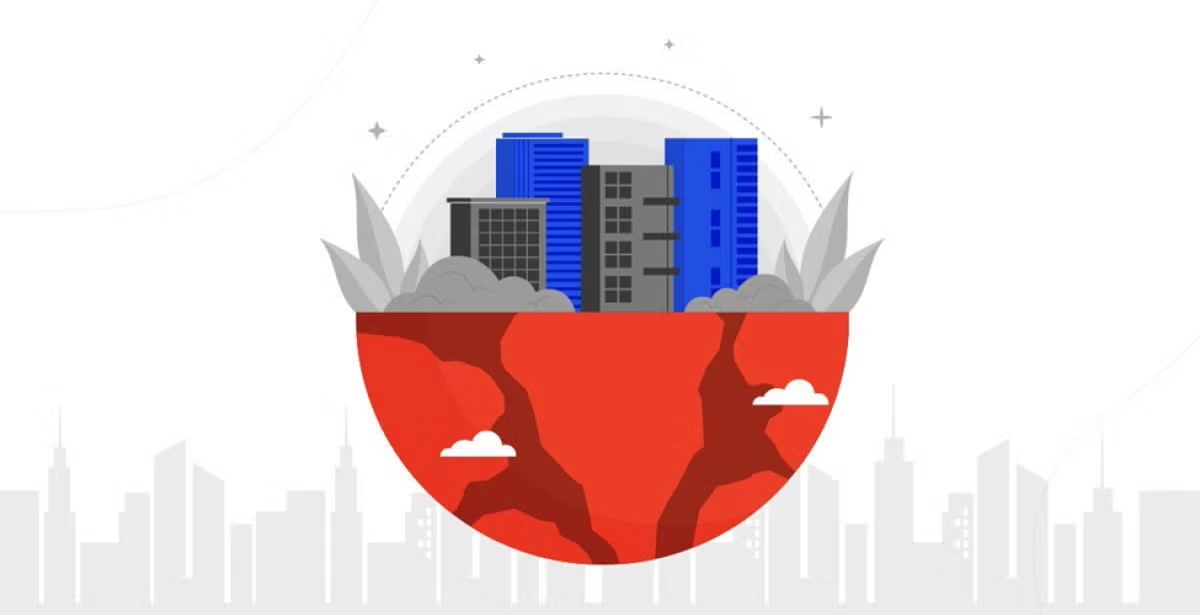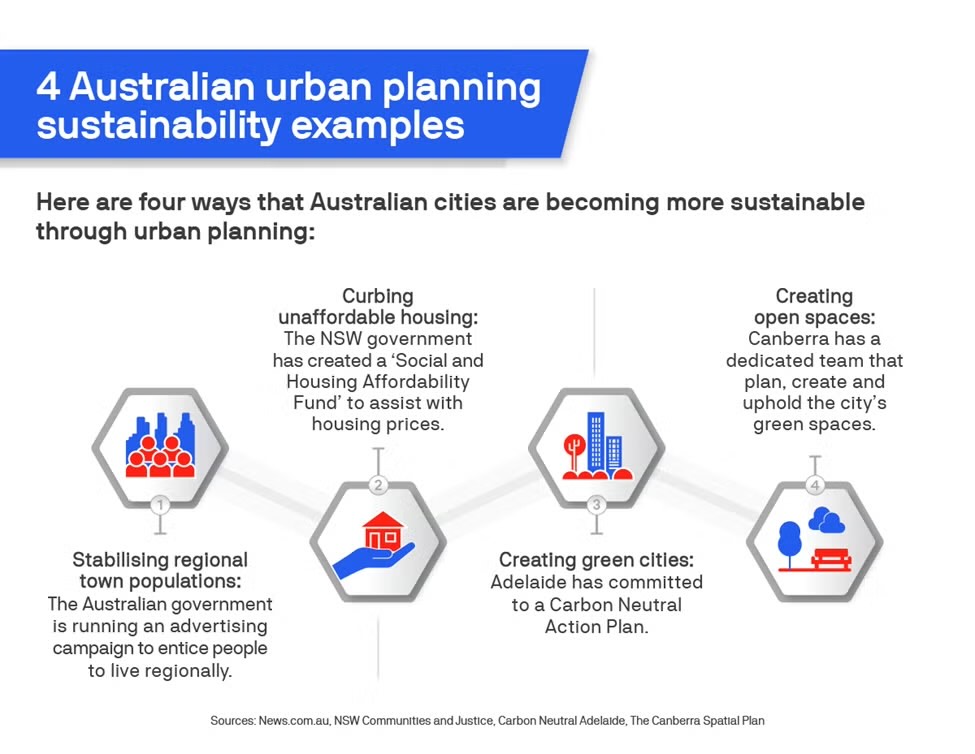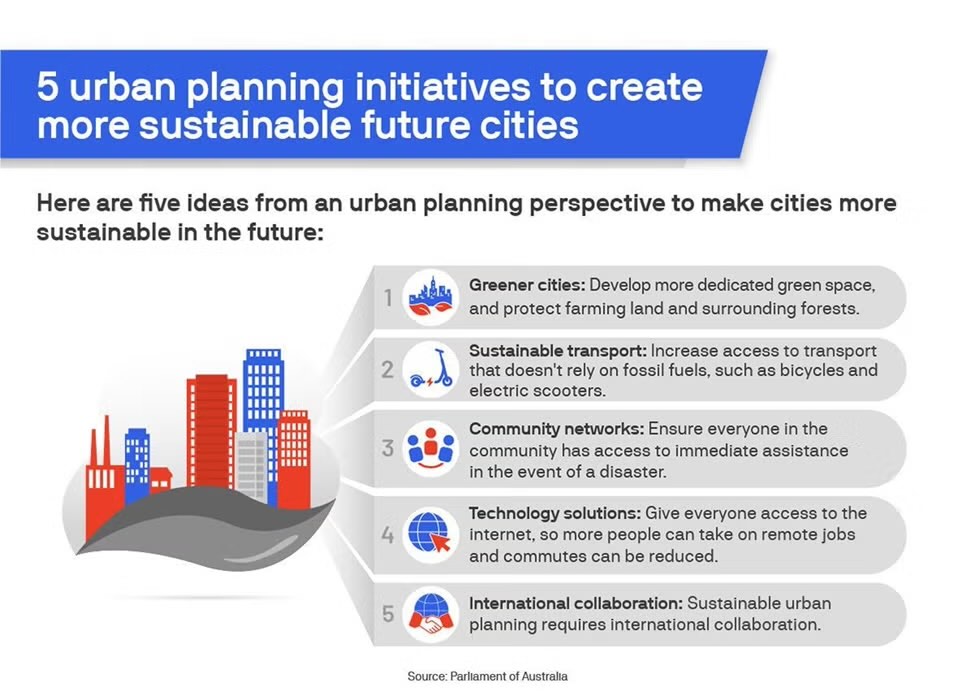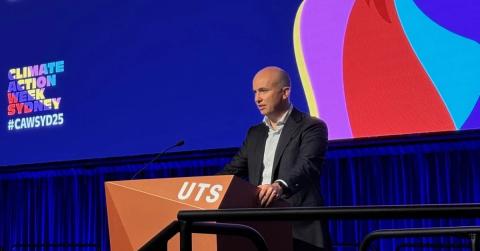Urban planning for sustainability and social justice


Australia’s urban areas have evolved considerably, with 86% of Australia’s 25 million residents now living in cities. Yet as Australian cities have evolved, so too have issues related to sustainable urban planning. Research shows that one of the big challenges facing sustainable urban planning efforts is the fact that the institutions working on the issue are often fragmented both in their knowledge sharing and their ability to affect change.
Sustainability in urban planning refers to the efforts to improve the social, economic and environmental wellbeing of a city to ensure a sustained high quality of living for its residents. These efforts are increasingly essential in Australia as cities grow. In the face of climate change, a focus on sustainability is needed to ensure that, for example, cities grow in a way that does not increase carbon emissions due to more car usage. It is also crucial to restoring social justice in Australia, given that economic inequality is growing at an alarming rate.
Fortunately, Australia is increasing its emphasis on sustainable urban planning and has a number of important success stories as a result.
Why is urban planning important to social and environmental sustainability?
As the population grows, cities grow, which is why urban planning is important. New houses are built, and more people need access to essential services such as schools, leisure activities, shopping centres and jobs. Yet without sustainable urban planning, cities can grow in a way that does not benefit the environment or the people living in it.
What is urban planning?
Urban planning refers to the design, regulation and planning of urban spaces. This planning may include:
- The physical use of land: For example, what type of housing will be built in a particular area?
- The economic use of land: For example, will the land be used for farming, commercial means or housing?
- The social impacts of this planning: For example, if land is used solely for housing, how will people access the amenities they need?
Many professionals are involved in urban planning, including engineers, architects, council planners and economists. To effectively plan cities, these professionals use data analysis, design, strategic thinking and public consultation to effectively forecast the impacts of their decisions.
Environmental and social sustainability in urban planning
With climate change accelerating and Australian cities growing at a rate of 1.6% every year, Australia needs more environmentally and socially sustainable urban planning.
For urban planning to be considered environmentally sustainable, it needs to design (or reform) cities in ways that reduce environmental degradation and resource depletion. The cities’ policy and governance must promote sustainability as well. This could mean drafting policies for the delivery of green infrastructure and open spaces. It could also mean focusing on public transportation over personal vehicles or focusing on renewable energy from solar and wind farms. Whatever the focus, governments — national, state and local — must ensure compliance and enforce consequences if policies are not followed.
For urban planning to be considered socially sustainable, it needs to ensure a consistently high quality of life for its current residents, without compromising the quality of life of future residents. To do this, planners need to focus on building cities in which all residents have access to transport to enable them to access jobs and education, for example. Residents also need to have equitable and fair access to housing, green spaces, food, leisure and culture.
The triple bottom line
As cities grow, they need frameworks to help them understand whether they are successfully implementing sustainable urban planning or not. One such framework that helps measure this is the triple bottom line (or TBL).
The TBL is an accounting framework that includes three important performance metrics: social, environmental and financial. The framework was created to expand the traditional definition of success in a capitalist economy, which is typically based on financial performance only.
All professionals involved with urban planning should be looking through the lens of TBL. For example, if property developers used TBL as a measure of success, they would think beyond the profit from building a housing development to consider factors such as the development’s environmental impact, or whether the development makes the community more equitable. Increasingly, councils are using TBL measures when considering new developments.
The evolution of sustainable urban planning
From a demographic perspective, a lot has changed in Australia over the last century. To give a few examples: Australia’s population increased from 4 million in 1901 to 26 million in 2023, with the percentage of the population living in urban areas increasing from 60% to 90%. Australia’s fertility rate has also decreased dramatically from 3.1 births per woman in 1921 to just 1.8 as of now. These changes have meant that urban planning has needed to evolve quickly and that sustainable urban planning is becoming increasingly important.
The history of sustainable urban planning
Consideration of sustainability in urban planning has been prevalent for at least a century. The concept came about in the late 1800s, when some large United States cities, including New York, began to implement policies that ensured access to drinking water, sewage and sanitary systems for all citizens.
In Australia, sustainable urban planning first became a consideration in the early 1900s. With Australia enjoying rapid economic growth, colonial-era planned cities had become crowded, and city suburbs had begun to spring up, which were characterised by poor sanitation and a lack of transport. The creation of these suburbs prompted the City Beautiful movement, in which academics and planners alike pushed for thoughtfully designed cities that were beautiful and accessible, and encouraged civic pride.
The City Beautiful movement influenced many admirable developments in Australia’s sustainable urban development efforts. Principles of the movement, including the idea of incorporating plentiful green spaces and making public transport accessible to all, were incorporated into Sydney’s planning starting in 1908 and were also pivotal in the design of Canberra.
Australia has a long history of investing in social sustainability in planning, especially when it comes to equality. In the period of sustained economic growth after the Second World War, Australian federal and state governments began developing extensive plans to guide development, including constructing public housing.
Although Australia has long focused on sustainable urban planning, it now must more urgently do so. As climate change accelerates, Australia needs to focus more on reducing carbon emissions, which will only be possible with sustainable cities that rely less on internal combustion engine vehicles (ICEVs). Currently, Australia is on track to experience hotter weather, more intense rainfall events and more extreme weather events, if sustainable planning is not taken seriously.
Developments in social and environmental sustainability
While sustainable city design is critically important, a number of barriers to achieving it remain.
One previous barrier to sustainable urban planning was the fact that the need for land to build housing was prioritised over and above allocating land to green space. However, this has changed following the 2020 bushfires in Australia, which prompted the creation of the Australian Royal Commission into National Natural Disaster Arrangements.
The commission’s findings led to a statement that all entities involved in planning should consider land use specifically as it relates to natural disaster risks. These considerations should include performing carbon assessments, prioritising water-sensitive designs and appraising the potential climate and disaster risks of any development. Currently, these findings have not yet been made into law.
Further resources
For more information, please see:
- Ambio, ‘A transformative mission for prioritising nature in Australian cities’: Academic article explaining the history of urban planning in Australia with a focus on now prioritising nature
- World Cities Report 2022, ‘Urban planning for the future of cities’: Report discussing future urban planning with a global focus
Strategies for sustainable urban development
With sustainable urban design a priority in Australia, the country needs strategies for urban planning that incorporate environmentally and socially responsible ideas. Fortunately, many strategies for sustainable urban development have recently been put into practice in several different Australian cities.
Curbing unaffordable housing: Sydney
Sydney has a long history of unaffordable housing and was recently ranked the second-least affordable housing market in the world.
To curb this, the New South Wales government is using instruments called state environmental planning policies (SEPPs) to introduce a range of measures, including:
- Changes to ensure the delivery of social and affordable housing through the Land and Housing Corporation
- New provisions that enable large-scale build-to-rent housing developments
- The consolidation of five existing planning policies to make housing development easier
- The inclusion of caravan parks and manufactured home estate provisions that enable these types of dwellings to be considered housing.
Creating green cities and circular economies: Adelaide
The city of Adelaide has a bold vision for sustainable urban planning: to become the first city in Australia to achieve zero avoidable waste to landfill by 2028. To do this, they are implementing a number of initiatives, many of which are already proving successful.
These initiatives include:
- Reuse and recycle hubs where city residents can deposit and recycle previously hard-to-recycle materials, including blister packets, printer cartridges and X-rays
- A food waste and compostable recycling zone, where city residents are encouraged, through an education program, to sort their recycling, including food waste
- A Rundle Mall public place organics trial program, in which local cafes are invited to switch from single-use plastics to compostable organic products
Adelaide’s vision is inspiring, and many residents are participating in the trial programs. However, more education and more initiatives like this are needed to ensure decreased waste.
Creating open spaces: Canberra
As one of Australia’s greenest cities, Canberra has always taken pride in its parks and trees. The Australian Capital Territory government has a long history of prioritising open spaces, most recently with its Living Infrastructure Plan. The plan includes the goals of:
- Becoming a climate-wise city by reducing risks from key climate change impacts
- Conserving and enhancing Canberra’s biodiversity and landscape to strengthen its sustainability, including increasing urban forests, open spaces, wildlife and water systems
- Becoming a prosperous city by recognising that its landscapes are an essential part of its economic prosperity
- Becoming a healthy city, by promoting community-wide health and wellbeing
To achieve these goals, Canberra plans to expand its asset management system and accounting framework to include living infrastructure and then aims to achieve 30% tree canopy cover and 30% permeable surfaces on Canberra’s urban footprint by 2045.
Challenges still exist
Each of these strategies represents a positive step toward creating sustainable cities. However, they are not without their challenges. For example, n. Sydney’s efforts to increase housing affordability have been criticised for being ‘too little, too late’ in a market where, despite multiple interest rate rises, property prices are still increasing.

Further resources
For further information on strategies for sustainable urban development, please see:
- Buildings, ‘Strategies for sustainable urban development: addressing the challenges of the 21st century’: Comprehensive academic guide on strategies for sustainable development, including examples
- City Monitor, ‘A sustainable Australia depends on what happens in its cities — that’s why it needs a national urban policy’: Article on sustainable development in Australia
- Australian Academy of Science, ‘Sustainable Australian cities and communities’: Outcome papers on case studies of sustainable urban planning in Australia
Future strategies for sustainable urban planning
Numerous Australian cities are already employing sustainable urban planning and sustainable city design measures with great success. Yet when it comes to sustainability in urban planning, planners must do more.
Here are five strategies for urban planning that councils and governments can implement to ensure sustainable urban design:
Greener cities
Greener cities, or cities with more trees, should always be a focus when it comes to sustainable city design or remodelling. Trees act as carbon sinks and can effectively draw down carbon from the atmosphere, which in turn can slow the rate of climate change.
Trees are also important for shade and more generally for the quality of life of city residents. Councils and governments should consider adding as many green spaces and trees as possible.
Sustainable transport
Relying on internal combustion engine vehicles creates problems for cities: They become polluted, suffer from low air quality and contribute to climate change. Spending time in traffic also leads to a diminished quality of life for residents.
Public transport is an important sustainable urban planning consideration. When cities have a range of effective public transport options, residents are more likely to use them — and rely on ICEVs less.
Community networks to support disaster relief
Australia’s disaster outlook is extremely concerning. Experts predict that the cost of natural disasters in Australia will double by 2050, meaning that communities need to be even better prepared for natural disasters.
A key urban planning strategy to support this is the creation of community networks. Community networks, such as support systems in nearby towns, can aid those affected quickly and easily.
Technology solutions
Technology can offer a number of innovative solutions that help with sustainable urban development efforts. One way that technology can do this is through monitoring.
Through smart monitoring and automation, cities can preserve and reuse water by installing smart metres that automatically turn off taps or redirect grey water.
International collaboration
While Australia is taking important steps toward sustainable city design, international collaboration can lead to critical innovations.
Australia has much to learn from world-leading sustainable cities such as Wellington, Zurich and Copenhagen.
Beyond establishing sustainable urban planning initiatives, there is considerable value in setting international goals and measuring data to ensure that initiative goals are achieved. Sharing data on elements of sustainability and social justice such as clean energy, public transport use and recycling can lead to broader insights that cross borders.

Further resources
- Sustainability Matters, ‘Urban planner forecasts the future of Aussie cities’: Article with forecasts for the future
- Parliament of Australia, ‘Building sustainable cities’: Government statement on sustainable urban planning in Australia
Sustainable urban planning for a greener future
Australia has enjoyed relative prosperity over its short history, and many of its cities have grown considerably — sometimes with sustainability in mind, but often not. Now, sustainable urban planning is even more critical in Australia, as the globe faces the increasing impacts of climate change.
Many Australian cities have successfully implemented elements of sustainable city design, but a more considered effort is needed to prepare for the future.
Infographic Sources:
Interested in shaping a more sustainable and equitable future?
Explore UTS Online’s suite of sustainability and planning courses designed for professionals who want to drive real change:
- Master of Urban Planning – plan smarter, more inclusive, and sustainable cities
- Master of Sustainable Energy – lead the transition to cleaner energy futures
- Master of Sustainable Leadership – create meaningful impact through values-led leadership





